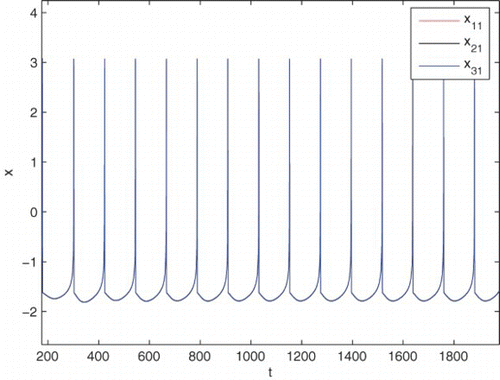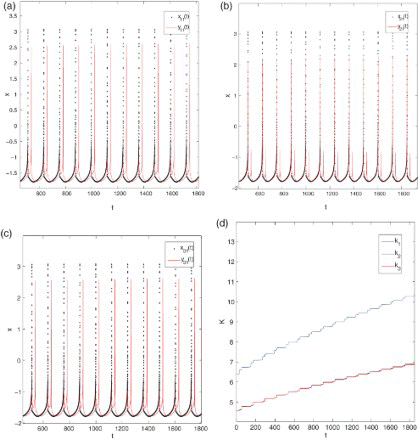Abstract
In this paper, by means of the invariance principle of differential equations, an adaptive feedback scheme is proposed to realize desynchronization in synchronous multi-coupled chaotic neurons by the mix-adaptive feedback effectively. Numerical simulations for the Hindmarsh–Rose neural model with self-coupling are illustrated which agree well with our theoretical analysis. It is observed that the feedback strengths asymptotically converge to a local fixed value in finite time, especially for linear coupling chaotic neurons with self-coupling. Furthermore, robustness of desynchronization in three coupled chaotic neurons on small mismatch of parameters is shown.
1. Introduction
Neurons and neural networks can be modelled by differential equations and dynamical systems at many different levels, depending upon diverse phenomena and the accuracy desired. They have been gaining increasing attention and recognition as a fundamental tool in understanding dynamical behaviours and response of real systems coming from different fields such as biology, social systems, linguistic networks, and technological systems Citation1Citation15Citation23Citation32. How to understand the synchronous activity in neurons has been an interesting subject in interdisciplinary sciences. Living tissues are complex organizations of individual cells. The activity of each cell within the tissue should be regulated in a coordinated manner to perform their specific functions. Synchronous activities in the central nervous system are the collective behaviours in the process of information transmission, so as to form a coherent and unified perception of the external world Citation4Citation9Citation28. Though the mechanism during the regulation process is very complex, a regular way is to exert control on neural transmission to change the neuron's activity.
The dynamics of neural networks have been widely investigated, with special emphasis on the interplay between the complexity in the overall topology and the local dynamical properties of the coupled nodes Citation7Citation18Citation25. As a typical kind of dynamics, synchronization and desynchronization in neural networks have become of significant interest in recent years. One of particular aims is to understand how synchronization and desynchronization depends on various parameters of the network, such as average distance, clustering coefficient, coupling strength, degree distribution, weight distribution, etc. Citation2Citation3Citation8Citation14Citation17Citation26Citation29. Different types of synchronization such as complete synchronization Citation6, phase synchronization Citation21, lag synchronization Citation17Citation22, almost synchronization Citation5, chaotic synchronization Citation27, and anticipated synchronization Citation33 have been described. Desynchronization is a process inverse to synchronization, where initially synchronized oscillating systems desynchronize as parameters change or they do so under the influence of an external force or feedback. Desynchronization is important. For example, in neuroscience and medicine, pathologically strong synchronization of neurons may severely impair the brain function as, for example, in Parkinson's disease or epilepsy Citation20Citation24Citation30Citation34. Effective desynchronization has been exploited as a tool for probing the functional significance of synchronized neural activity underlying perceptual and cognitive processes or as a mild treatment for neurological disorders like Parkinson's disease Citation13Citation19.
Recently, extensive works have been done towards understanding the synchronization of globally coupled phase oscillators, and in particular, possible methods for desynchronizing such systems with short sequences of pulses Citation11Citation31Citation35. In Citation11, an adaptive feedback scheme was proposed to achieve complete synchronization. Based on this feedback scheme, adaptive synchronizations of neural networks with or without delay were described Citation31Citation35. This proposed scheme appears simple and is robust against the effect of small noise. It is of great importance for the treatment of neurological disorders like Parkinson's disease and essential tremor, and can also be used to design new psychophysiological and cognitive experimental techniques. In these studies, considering transmission delay in some neural models becomes necessary. In practice, the information is not instantaneous in general because of the finite propagation velocity and delay in the transmission of signal, thus the delay should be an indispensable factor in these circumstances. In our previous works Citation17Citation29, we once explored synchronization for neural networks with time delay by using the theory of asymptotic stability. In the present paper, we develop an adaptive feedback scheme to study desynchronization in synchronous multi-coupled chaotic neurons.
The rest of the paper is organized as follows. In Section 2, a theoretic result is presented on desynchronization in synchronous multi-coupled chaotic neurons. As an example, a model of three coupled Hindmarsh–Rose (HR) neurons is discussed by the adaptive feedback scheme. Furthermore, we find that small mismatch parameters on the effects of the desynchronization are robust. Section 3 is a brief conclusion.
2. Main results
2.1. Analytical theorem
In this section, based on the invariance principle of differential equations Citation12, we are concerned with desynchronization in synchronous multi-coupled chaotic neurons with the mix-adaptive delay feedback. Consider the following synchronous multi-coupled chaotic neural system:
where
,
is a nonlinear vector function, and Hi may be linear or nonlinear. We called Equation (1) the reference system.
Let be a chaotic bounded set of system (1), which is globally attractive. In general, we assume that
(I) the nonlinear vector function f(xi) is globally Lipschitz with positive constants l>0 such that
for any x(t),
;
(II)
is local Lipschitz with positive constants mi such that
In what follows, we consider the system of multi-coupled chaotic neurons with the mix-adaptive feedback in the form
where yi represents the response state, ui represents the feedback control with the delayed state
. We called it the controlled system. From Citation11Citation31, the feedback strength
is adapted according to the following scheme Citation35:
where
and i≠j.
Let and
. Apparently, if τi=0, then ei=xi−yi. From Equations (1) and (2) we deduce that
Definition 1
For systems (1) and (2), we say that they possess the property of desynchronization, if there exists as
i=1, 2, …, n.
Theorem 1
Assume that conditions (I) and (II) hold, and systems (1) and (2) satisfy the adaptive scheme (3). Then desynchronization in synchronous coupled chaotic neurons can be achieved, that is, .
Proof
[Proof of Theorem 1] According to Equations (3) and (4), we construct a Lyapunov function as
where L is a constant and
Calculating the derivative of Eh(t) along the trajectory of the error system (4) yields
If and only if
are all equal to zero, then we have
. Thus, we have
, that is,
,
. ▪
Remark 1 According to above proposed desynchronization scheme, we can obtain desynchronization in synchronous coupled chaotic neurons effectively. The above result appears rather general.
2.2. Applications to HR models
In this section, we consider a model of the HR neurons Citation10 described by the following equations:
where x1 represents the membrane potential, x2 represents a recovery variable associated with the fast current, x3 denotes the adaption current, and
and x̄ are real constants. In our previous work Citation16, we studied the stability by classifying neighbourhood regimes near the Fold-Hopf points and illustrated the complex bursting-spiking firing modes associated with Fold-Hopf bifurcations by numerical simulations. Here we take
and choose Ix as a control parameter. The change of the value of Ix causes rich firing behaviours. System (5) exhibits multiple time-scale chaotic bursting behaviours for
, especially in the case of Ix=3.2 ().
For convenience, we consider the system of three coupled chaotic HR neurons for two cases ().
Figure 2. (a) Ring coupling chaotic neurons with self-coupling; (b) linear coupling chaotic neurons with self-coupling.
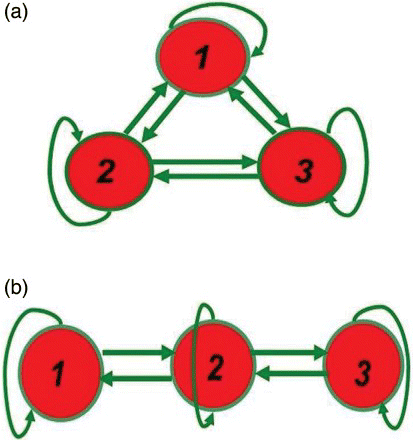
Case (a): ring coupling chaotic neurons with self-coupling. Consider the system of three ring-coupled chaotic HR neurons with self-coupling:
where
, relevant parameter values are the same of system (5), and
When , synchronization has been achieved, the corresponding numerical results are shown in . As real coupled neurons are concerned, the information from the presynaptic neuron is transmitted to the postsynaptic one with certain time delay. Time delays are inherent in neuronal transmissions. Thus it is important to seek the controlling method of synchronous neurons.
Figure 3. The portrait of system (6) with respect to ring coupling chaotic neurons with self-coupling for ϵ=2.0.
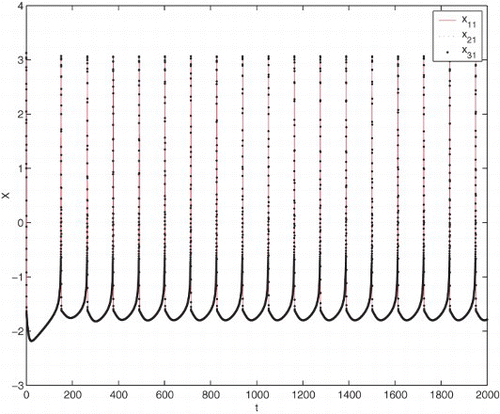
In what follows, the corresponding three coupled chaotic neurons are described by the following system:
where yi represents the response state, τi represents time delay,
and
. In order to discuss the synaptic effect to the membrane potential through the gap junction between neurons, we take the synaptic coupling strength as ki. Here the feedback strength ki is adapted according to the following scheme:
We take parameters
, Ix=Iy=3.2, and the initial feedback strength 0.01 to investigate desynchronization in the system of three synchronous coupled chaotic neurons.
The corresponding numerical simulations are shown in . It is shown in –(c) with the delay τ1=25 and τ3=50, respectively, that the coupled system achieves desynchronization by using the mix-adaptive feedback control. Furthermore, from , the feedback strength k1, k2, and k3 asymptotically converges to a local fixed value, respectively.
Figure 4. (a)–(c) Desynchronization for three ring-coupled chaotic neurons with the delay τ1=25 and τ3=50, respectively; (d) the temporal evolution of k1, k2, and k3 for Ix=Iy=3.2.
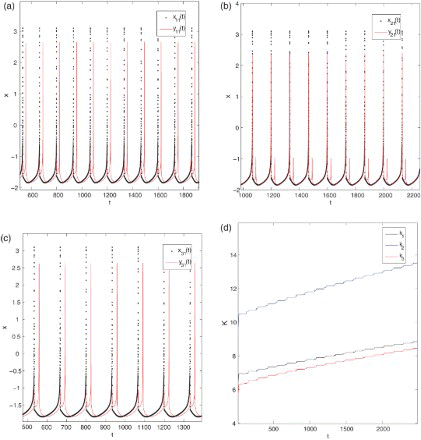
Nonidentity exists everywhere in nature. Thus, it is useful to investigate destructuralization in three coupled HR chaotic neurons with the small mismatch of parameters. We take Ix=3.2 and Iy=3.18, respectively. It is presented in –(c) with the delay τ1=25 and τ3=50, respectively, that desynchronization of the coupled system can be achieved by using the mix-adaptive feedback control. Furthermore, we can observe the robustness of feedback strength of desynchronization by comparing with .
Figure 5. (a)–(c) Desynchronization for three ring-coupled chaotic neurons with the delay τ1=25 and τ3=50, respectively; (d) the temporal evolution of k1, k2, and k3 for Ix=3.2 and Iy=3.18.
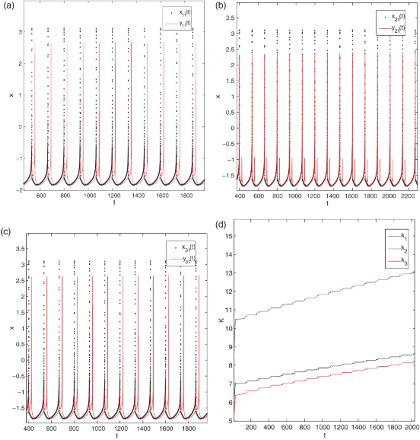
Case (b): linear coupling chaotic neurons with self-coupling.
Similar simulations can be obtained for linear coupling chaotic neurons with self-coupling. In , simulations for linear coupling chaotic neurons with self-coupling are illustrated. It is shown from –(c) with the delay τ1=25 and τ3=50, respectively, that desynchronization of the coupled system can be achieved by applying the mix-adaptive feedback control. In particular, the feedback strength can be a stable fix value (). Similarly, desynchronization in three linear coupled chaotic neurons on the small mismatch of parameters is also robust.
3. Conclusion
In this paper, we applied an adaptive feedback method to determine the desynchronization condition of neural systems, which enables us to observe desynchronization in synchronous multi-coupled chaotic neurons. Based on the invariance principle of differential equations and matrix inequality, applying the mix-adaptive feedback we obtained desynchronization in synchronous multi-coupled chaotic neurons. Numerical simulations are in agreement with our analytical result.
Acknowledgements
This work is supported by the National Natural Science Foundation of China under Grants No. 10972018 and No. 11072013. This work is also partially supported by UTPA Faculty Council Grant under 145MATH04. Authors thank Dr Xiaohui Wang for providing us with the drawing technique.
References
- S. N. Dorogovtsev, J. F.F. Mendes, Evolution of Networks: From Biological Nets to the Internet and WWW, Oxford University Press, Oxford 2003.
- Z. S. Duan, G. Chen, L. Huang, Complex network synchronizability: Analysis and control, Phys. Rev. E 76 (2007), pp. 056103-1–056103-6 (doi:10.1103/PhysRevE.76.056103) doi: 10.1103/PhysRevE.76.056103
- M. G. Earl, S. H. Strogatz, Synchronization in oscillator networks with delayed coupling: A stability criterion, Phys. Rev. E 67 (2003), pp. 036204-1–036204-4 (doi:10.1103/PhysRevE.67.036204) doi: 10.1103/PhysRevE.67.036204
- R. Eckhorn, R. Bauer, W. Jordan, M. Brosch, W. Kruse, M. Munk, H. J. Reitboeck, Coherent oscillations: A mechanism of feature linking in the visual cortex?, Biol. Cybern. 60 (1988), pp. 121–130 (doi:10.1007/BF00202899) doi: 10.1007/BF00202899
- R. Femat, G. Solis-Perales, On the chaos synchronization phenomena, Phys. Lett. A 262 (1999), pp. 50–60 (doi:10.1016/S0375-9601(99)00667-2) doi: 10.1016/S0375-9601(99)00667-2
- H. Fujisaka, T. Yamada, Stability theory of synchronized motion in coupled oscillator systems, Progr. Theoret. Phys. 69 (1983), pp. 32–47 (doi:10.1143/PTP.69.32) doi: 10.1143/PTP.69.32
- J. Gomez-Gardenes, Y. Moreno, A. Arenas, Synchronizability determined by coupling strengths and topology on complex networks, Phys. Rev. E 75 (2007), pp. 066106-1– 066106-11 (doi:10.1103/PhysRevE.75.066106) doi: 10.1103/PhysRevE.75.066106
- C. M. Gray, Synchronous oscillations in neural systems: Mechanisms and functions, J. Comput. Neurosci. 11 (1994), pp. 11–38 (doi:10.1007/BF00962716) doi: 10.1007/BF00962716
- C. M. Gray, P. König, A. K. Engel, W. Singer, Oscillatory responses in cat visual cortex exhibit inter-columnar synchronization which reflects global stimulus properties, Nature 338 (1989), pp. 334–337 (doi:10.1038/338334a0) doi: 10.1038/338334a0
- J. L. Hindmarsh, R. M. Rose, A model of the nerve impulse using two first order differential equations, Nature 296 (1982), pp. 162–164 (doi:10.1038/296162a0) doi: 10.1038/296162a0
- D. B. Huang, Simple adaptive-feedback controller for identical chaos synchronization, Phys. Rev. E 71 (2005), pp. 037203 (doi:10.1103/PhysRevE.71.037203) doi: 10.1103/PhysRevE.71.037203
- J. P. Lasalle, Some extensions of Lyapunov's second method, IEEE Trans. Circuit Theory 7 (1960), pp. 520–527
- X. Li, G. Chen, Synchronization and desynchronization of complex dynamical networks: An engineering viewpoint, IEEE Trans. Circuits Syst. I 50 (2003), pp. 1381–1390 (doi:10.1109/TCSI.2003.809808) doi: 10.1109/TCSI.2003.809808
- C. G. Li, G. Chen, Synchronization in general complex dynamical networks with coupling delays, Phys. A 343 (2004), pp. 263–278 (doi:10.1016/j.physa.2004.05.058) doi: 10.1016/j.physa.2004.05.058
- Z. E. Ma, J. Li, Dynamical Modeling and Analysis of Epidemics, World Scientific, Singapore 2009.
- S. Q. Ma, Q. S. Lu, Z. Feng, Dynamics and double Hopf bifurcations of the Rose–Hindmarsh model with time delay, Int. J. Bifur. Chaos 19 (2009), pp. 3733–3751 (doi:10.1142/S0218127409025080) doi: 10.1142/S0218127409025080
- S. Q. Ma, Q. S. Lu, Z. Feng, Synchrony and lag synchrony on a neuron model coupling with time delay, Int. J. Nonlinear Mech. 45 (2010), pp. 559–665 (doi:10.1016/j.ijnonlinmec.2010.03.003) doi: 10.1016/j.ijnonlinmec.2010.03.003
- T. Nishikawa, A. E. Motter, Y. C. Lai, F. C. Hoppensteadt, Heterogeneity in oscillator networks: Are smaller worlds easier to synchronize?, Phys. Rev. Lett. 91 (2003), pp. 037203-1–037203-4 (doi:10.1103/PhysRevLett.91.014101) doi: 10.1103/PhysRevLett.91.014101
- O. V. Popovych, C. Hauptmann, P. A. Tass, Effective desynchronization by nonlinear delayed feedback, Phys. Rev. Lett. 94 (2005), pp. 164102-1–164102-4 (doi:10.1103/PhysRevLett.94.164102) doi: 10.1103/PhysRevLett.94.164102
- O. V. Popovych, C. Hauptmann, P. A. Tass, Desynchronization and decoupling of interacting oscillators by nonlinear delayed feedback, Int. J. Bifur. Chaos 16 (2006), pp. 1977–1987 (doi:10.1142/S0218127406015830) doi: 10.1142/S0218127406015830
- M. G. Rosenblum, A. S. Pikovsky, J. Kurths, Phase synchronization of chaotic oscillators, Phys. Rev. Lett. 76 (1996), pp. 1804–1807 (doi:10.1103/PhysRevLett.76.1804) doi: 10.1103/PhysRevLett.76.1804
- M. G. Rosenblum, A. S. Pikovsky, J. Kurths, From phase to lag synchronization in coupled chaotic oscillators, Phys. Rev. Lett. 78 (1997), pp. 4193–4196 (doi:10.1103/PhysRevLett.78.4193) doi: 10.1103/PhysRevLett.78.4193
- S. H. Strogatz, Exploring complex networks, Nature 410 (2001), pp. 268–276 (doi:10.1038/35065725) doi: 10.1038/35065725
- P. A. Tass, Desynchronization of brain rhythms with soft phase-resetting techniques, Biol. Cybern. 87 (2002), pp. 102–115 (doi:10.1007/s00422-002-0322-5) doi: 10.1007/s00422-002-0322-5
- X. G. Wang, Y. C. Lai, C. H. Lai, Enhancing synchronization based on complex gradient networks, Phys. Rev. E 75 (2007), pp. 056205-1–056205-5
- X. G. Wang, Pattern evolution in non-synchronizable scale-free networks, Eur. Phys. J. B 75 (2010), pp. 285–297 (doi:10.1140/epjb/e2010-00158-6) doi: 10.1140/epjb/e2010-00158-6
- Q. Y. Wang, Q. S. Lu, G. Chen, D. H. Guo, Chaos synchronization of coupled neurons with gap junction, Phys. Lett. A 356 (2006), pp. 17–25 (doi:10.1016/j.physleta.2006.03.017) doi: 10.1016/j.physleta.2006.03.017
- Q. Y. Wang, Q. S. Lu, G. Chen, Ordered bursting synchronization and complex wave propagation in a ring neuronal network, Phys. A 374 (2007), pp. 869–878 (doi:10.1016/j.physa.2006.08.062) doi: 10.1016/j.physa.2006.08.062
- Q. Y. Wang, Z. S. Duan, G. Chen, Z. Feng, Synchronization in a class of weighted complex networks with coupling delays, Phys. A 387 (2008), pp. 5616–5622 (doi:10.1016/j.physa.2008.05.056) doi: 10.1016/j.physa.2008.05.056
- X. Wang, S. G. Guan, Y. C. Lai, B. W. Li, C. H. Lai, Desynchronization and on–off intermittency in complex networks, Europhys. Lett. 88 (2009), pp. 281–299
- Q. Y. Wang, Q. S. Lu, Z. S. Duan, Adaptive lag synchronization in coupled chaotic systems with unidirectional delay feedback, Int. J. Nonlinear Mech. 45 (2010), pp. 640–646 (doi:10.1016/j.ijnonlinmec.2009.01.001) doi: 10.1016/j.ijnonlinmec.2009.01.001
- D. J. Watts, Small-Worlds: The Dynamics of Networks between Order and Randomness, Princeton University Press, PrincetonNJ 1999.
- H. U. Voss, Anticipating chaotic synchronization, Phys. Rev. E 61 (2000), pp. 5115–5119 (doi:10.1103/PhysRevE.61.5115) doi: 10.1103/PhysRevE.61.5115
- Y. Zhai, I. Z. Kiss, P. A. Tass, J. L. Hudson, Desynchronization of coupled electrochemical oscillators with pulse stimulations, Phys. Rev. E 71 (2005), pp. 065202-1–065202-4 (doi:10.1103/PhysRevE.71.065202) doi: 10.1103/PhysRevE.71.065202
- Y. Zhao, Q. S. Lu, Desynchrony in two chaotic neurons with uncertain couple and mix-adaptive feedback, Adv. Cogn. Neurodyn. 2 (2009), pp. 327–331

